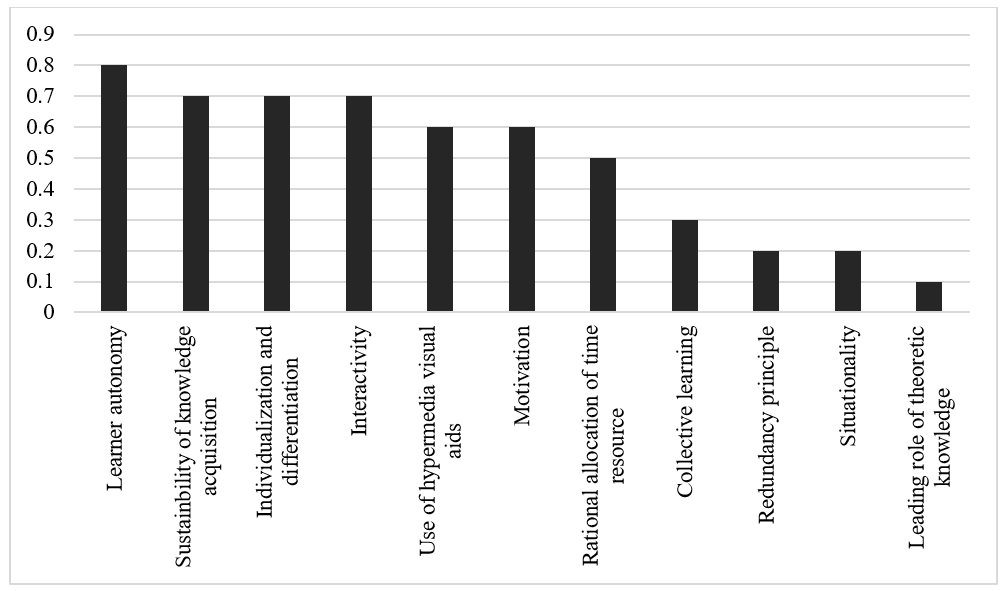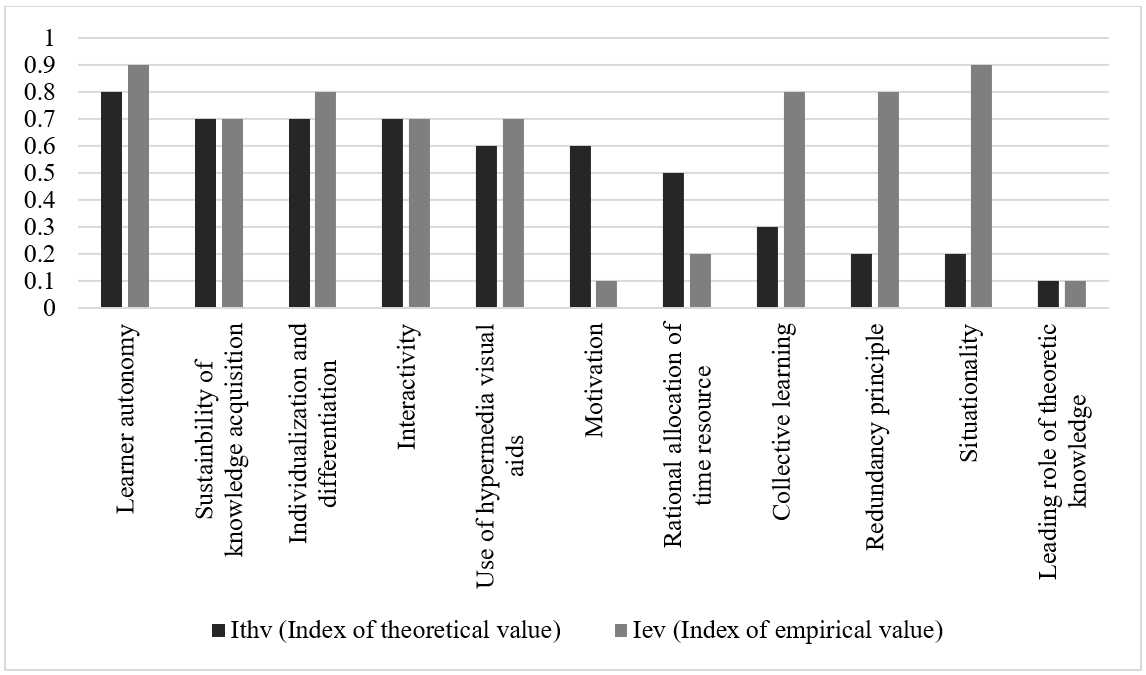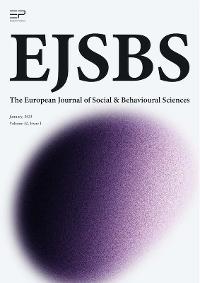Didactic Principles of Modeling Virtual Learning Environments: the Analysis of Theoretical and Empirical Value
Abstract
The article aims to analyze a range of didactic principles that have to be included in methodological substantiation when creating a model of Virtual Learning Environment (VLE) or other models of distance learning. To systematize and range the didactic principles in order of their pedagogical importance, several quantitative and qualitative research methods were used, including content analysis, questionary-based survey, and statistical data processing. The main aim of the study was to compare the didactic principles’ theoretical impact, which is based on the content analysis results, and their empirical value, indicated by students’ responses to the survey. The initial findings indicate the substantial difference between the didactic principles that are most frequently referenced in theoretical studies and the principles that are practically required to address students’ needs. The main outcome of the research is the assignment of the didactic principles into three categories: those having low theoretical and empirical value; those having low theoretical but high empirical value; and those having both high theoretical and empirical value. As such, the results of the study allow for the development of VLEs in various disciplines using relevant didactic principles that have both theoretical and empirical value.
Keywords: Digital didactics, virtual learning environment, distance learning, didactic principles
Introduction
Nowadays, the active use of information and communication technologies (ICTs) in the educational process is the result of both the general trend to digitalize education and the forced transition to the implementation of many educational programs in a distance format due to the Covid19 pandemic.
The demand for organizing distance and blended learning for entire classes of learners, groups of students, and departments within companies actualizes the issues of modeling VLEs as a set of ICTs and digital didactic resources specifically selected to achieve learning objectives (Weindorf-Sysoeva et al., 2018). In many respects interest in modeling such environments is also triggered by the provisions of the systematic methodological approach that implies not only searching for new resources and describing their didactic potential but also organizing digital resources into a single-unit functioning system (Polot, 2020). Therefore, one of the most important issues of modern didactics is systematization, critical analysis, and the actualization of didactic principles of VLE modeling to successfully address the current educational conditions as well as students’ needs in online education.
The literature review assisted in identifying several approaches to selecting and describing the didactic principles in the VLE modeling process. The first one is to transform the traditional didactic principles into the digital didactic principles based on the analysis of WEB 2.0 specific features. For instance, Racheva (2018) stated that the principle of activity is transformed into the interactivity principle that implies constructing VLEs mainly on the basis of ICTs with automatic feedback function and those designed for synchronous online communication. The second approach is to adapt the existing didactic principles to the VLE model composition. For example, as indicated by Yonghe and Lei (2022), the traditional principle of sustainability of knowledge acquisition should be implemented in any model of distance learning considering the impact of the WEB 2.0 environment on the process of sustainable knowledge acquisition. Another approach is detected in studies by Chang and Kuo (2021), Hamilton et al. (2020), and others where the researchers describe the didactic principles primarily on the basis of innovative ICTs, evaluating the features according to their didactic potential. For example, Jensen and Konradsen (2018) explore the immersive learning principle on the example of using head-mounted displays for improving cognitive skills acquisition process.
While the abovementioned approaches make a substantial contribution to developing digital didactics in general, it is also necessary to gather feedback from students and teachers to provide high-demand VLEs (Tanis, 2020)
Problem Statement
Research on the process of VLE modeling has shown that the range of didactic principles necessary to provide methodological substantiation of the VLE models is quite established in scientific papers. Such didactic principles are, for instance, the principles of autonomy, situationality, interactivity, hypermedia visual aids, redundancy, collective learning, and others (Burns, 2011; Doneva et al., 2006; OECD, 2017; Polot, 2020). At the same time, the literature review has indicated that little has been done to test whether the importance of those didactic principles corresponds to distance learners’ current needs and expectations. Therefore, it is necessary to actualize the set of didactic principles that reflect not only robust theoretical grounding but also complies with students’ expectations of modern VLEs.
Research Questions
The attempt to identify the most relevant didactic principles of VLE modeling in terms of their significance both theoretically and practically is based on addressing the following research questions:
- which didactic principles devoted to the development of VLEs and distance learning models in general are most frequently referenced in scientific sources?
- which didactic principles and their corresponding application features in VLE modeling are significant to students?
- what are the similarities and differences between the theoretical and empirical value of the didactic principles?
- what is the specific set of VLE modeling principles necessary to achieve learning objectives and satisfy students’ expectations from online learning?
Purpose of the Study
The research aims to identify the set of didactic principles to be implemented in any modern model of a VLE or other forms of distance learning. The study is also focused on revealing those features of didactic principles that are of no or little importance from the students’ perspective and, therefore, despite being widely addressed in scientific papers, have low empirical value.
Research Methods and Materials
To achieve the aim of the research the following methods were used: content analysis, pilot study (questionnaire-based survey), and statistical methods of data processing. The study was conducted in four stages, each addressing one of the research questions outlined above.
First, the content analysis was conducted based upon the main distinguishing criteria which was the number of references to didactic principles of VLE modeling in scientific papers related to interactivity, autonomy, redundancy, motivation, etc. (see Table 1). For each didactic principle a theoretical value indexwas derived (see Figure 1) referring to the sum of references to the principle in the studies divided by the number of sources.
Materials for the content analysis included various scientific papers (scientific articles, textbooks, dissertations), such as “Pedagogical Technologies of Distance Learning” by Polat et al. (2020); “Theoretical Approaches to the Design of Electronic Educational Environment in Technology Education” by Weindorf-Sysoeva et al. (2018); “Information and Communication Technologies in Pedagogical Education” by Kiselyov et al. (2020); “On the Didactic Principles, Models And E-Learning” by Doneva et al. (2007); “Distance Education for Teacher Training: Modes, Models, and Methods” by Burns (2011).
The subsequent step was the implementation of a survey among 57 students of Psychological Faculty at Saint-Petersburg State University. The purposive sampling method was used to select students who at the time of the research were completing general education programs in a distance or blended format. The sample included 34 female and 23 male students aged 19-23 years old. Both bachelor (41) and master (16) degree students were included to the sample. The survey was conducted to determine the features of distance learning interaction that indicate the implementation (or lack thereof) of specific didactic principles in VLE modeling that are important to learners. The survey implemented via Google Forms included 11 closed-ended questions adapted from the study conducted by Rogozin (2021). The monograph presents the methodology of non-random sampling that made it possible to ensure a high level of reliability and validity while conducting research on distance learning processes during Covid-19 among teachers and students at Russian Presidential Academy of National Economy and Public Administration (Rogozin, 2021). The questionary included such closed-ended questions as: “Is it important for you to be able to choose a specific format of learning materials (video, presentation, text, etc.)?”; “Do you consider the motivational stage necessary at the beginning of each educational module/topic/lesson?”; “Do digital badges, awards and leaderboards motivate you to put more effort into the process of distance learning?”, etc. (see Table 2). An empirical value index was formed for each of the didactic principles based on the results obtained through statistical data processing which converted the percentages of received responses into indices (see Figure 2).
The final stage of the research included the comparison of the theoretical and empirical value indices to actualize the set of relevant didactic principles necessary to develop a theoretically robust yet student-friendly VLE model.
Findings and Discussion
Didactic principles and their application in distance learning for the content analysis criteria
Didactic principles are known as universal educational norms that require following certain patterns, activities, and rules to project and organize an efficient educational environment (including a virtual one) (Soldatov & Soldatova, 2021). The range of didactic principles for further content analysis was specified in the initial stage of the literature review. The principles that had been mentioned at least twice were tracked down. It should be mentioned, though, that the most fundamental didactic principles have not been included for further analysis as the relevance of their application in distance or face-to-face learning has no reason to be questioned (e.g., the principle of systematization and continuity, the principle of conscious participation in the education process, etc.). Thus, the list included 11 principles, which are:
Learner autonomy
The principle of learner autonomy implies that students take responsibility for what and how they learn (Hu & Zhang, 2017). The VLE, therefore, should provide a variety of tools and means of communication to students to operate independently of the teacher’s control.
Sustainability of knowledge acquisition
The principle of sustainability of knowledge acquisition assumes that all modules of an online course are interrelated, with each new module’s material premised on previously constructed knowledge drawn from previous modules (Leontieva et al., 2017).
Use of hypermedia visual aids
Using hypermedia visual aids is a transformed didactic principle of visibility (using visual aids) that involves including different types of multimedia to deliver educational material to learners (Setyawati & Muhtadi, 2019).
Interactive participation in the education process
The principle of interactivity (interactive participation) in VLE modeling suggests prioritizing automatic feedback with interactive buttons allowing students to interact and communicate with each other both synchronously and asynchronously (Leontieva et al., 2017).
Motivation
The motivation principle implies using different digital forms of rewards (e.g., digital badges, scores, prizes, leaderboards, etc.) as well as implementing motivation-forming modules at the beginning of online courses or including motivational stages in synchronous online classes (Elshareif & Mohamed, 2021).
Individualization and differentiation
The principle of individualization and differentiation means that students should be provided with a variety of tasks, learning tools, and self-control means as well as in constructing a VLE in a way that allows each to rely on their own pace and tempo of completing learning tasks (Vainshtein et al., 2019).
Situationality
The situationality principle refers to deploying case-based learning activities which connect theory with practice by providing learning tasks embedded in certain professionally-oriented situations, and assigning specific professionally-oriented roles to students (Leontieva et al., 2017).
Collective learning
Implementing the collective learning principle in a VLE requires searching for ways to organize learners’ online collaboration in pairs or groups for them to share and construct collective knowledge in a continuous synergetic process (Mayer & Fiorella, 2021).
Redundancy
The redundancy principle implies that a VLE has multiple learning activities and forms of control to better suit different learning styles (Sherbina et al., 2020).
Leading role of theoretic knowledge
The principle of the leading role of theoretic knowledge evaluates different forms of online learning as primarily theoretic knowledge databases serving as additional sources to widen theoretical background in a specific training field (Kiselyov & Bochkova, 2020).
Rational allocation of time resources
Finally, the principle of rational allocation of time resources suggests that it is important for students to be able to select study schedules, the length of online classes, etc. (Prigozhina & Trostina, 2017).
The results of the content analysis
The purpose of the content analysis was to record the number of references to the didactic principles with the subsequent description of their application in distance learning. The study revealed that the most addressed principles in VLE modeling theory are the following: autonomy, sustainability of knowledge acquisition, use of hypermedia visual aids, interactivity, motivation, and individualization and differentiation (see Table 1).
To further apply statistical methods of data processing to achieve the aim of the research, theoretical value indices (Ithv) were assigned to each principle as a result of dividing the number of references by the total number of scientific resources used for the content analysis (21) (see Table 1). The principles were then ranged according to their Ithv starting from those having a high theoretical impact on the left to the principles with low Ithv on the right (see Figure 1).

The results of the survey
At the third stage of the study, a survey was conducted among selected students to determine the most important properties and functions of a VLE (from learners’ perspective) as preferable features of distance learning interaction that indicate the implementation (or lack thereof) of specific didactic principles in modeling VLEs.
More specifically, the students were asked whether the features implied by the realization of certain didactic principles were important for them. For example, such questions as “Do you consider the motivational stage necessary at the beginning of each educational module/topic/lesson?” or “Do digital badges and awards motivate you to put more effort into the process of distance learning?” aimed at revealing empirical value of the motivation principle. The examples of the core range questions and the percentages of responses are presented in Table 2.
It should be mentioned that the main survey was followed by its second part that included some additional multiple-choice questions that helped better understand students’ educational needs and preferences. For example, “Which forms of hypermedia visual aids to learning materials do you believe to be most efficient?”, and others. These were designed to uncover more information that could help enhance VLE implementation. However, the results obtained in the second part of the survey are not discussed in this article as they have no direct correlation with the implementation of didactic principles and were used in a broader study.
The statistical data processing of the data involved converting the percentages of received responses into coefficients, Empirical value indices (Iev) were formed for each of the didactic principles and were placed in the range chart beside their Ithv (see Figure 2).

The outcomes of the content analysis and survey responses
The fourth stage of the research involved the comparison of the Ithv and Iev of didactic principles to uncover the similarities and differences in the significance of didactic principles in theory and practice (see Figure 2). It was found, in particular, that the Iev of the didactic principle of situationality is significantly higher than its Ithv (0.9 vs. 0.2). Students noted that they consider it important to acquire knowledge in a professionally-oriented situation. The presence of role-based components of an online class was also mentioned as a desirable feature. The Ithv of the principle of rational allocation of time resources turned out to be higher than its Iev (0.5 vs. 0.2). Only 19% of respondents noted that they want to choose the time of training, the pace and timing of educational tasks independently. The principle of autonomy was shown to be almost equal for Ithv and Iev (0.8 and 0.9, respectively). At the same time however, more than 70% of respondents noted that, despite seeking autonomy in the choice and order of performance of training assignments, they consider it necessary to perform most of the training interaction in a VLE under the teacher’s control. The theoretical and empirical value of the sustainability of knowledge acquisition principle was equally distributed (0.7). In addition, half of the respondents noted that they want to participate in project-based forms of self-study to apply the obtained knowledge in practice. The need to increase the amount of paired and group interaction in VLE models is indicated by the difference between the Iev of the principle of collective learning and its Ithv (0.8 vs. 0.3, respectively). Significant Differences were also revealed for the didactic principle of redundancy; 0.8 Iev compared to 0.2 Ithv. More than 90% of the respondents highlighted the importance of the independent choice of the educational materials delivery formats, forms of control, etc. Finally, 87% of the respondents stated that they had a sufficient level of intrinsic and extrinsic motivation and considered the motivational stage redundant in distance learning formats (Iev of the motivation principle – 0.1). The didactic principles of interactivity, use of hypermedia visual aids, and individualization and differentiation showed equal or almost equal values of Ithv and Iev ranging between 0.7 – 0.8 for both.
Evaluation and systematization of the didactic principles in VLE modeling
The outcomes of each research stage and the data analysis made it possible to identify the three broad sets of valuable didactic principles to consider in the development of VLEs.
- The principles which garnered high theoretical and empirical values were interactivity, use of hypermedia visual aids, individualization and differentiation, student autonomy, and sustainability of knowledge acquisition.
- The principles with low theoretical value but high empirical value include situationality, the collective learning, and redundancy.
- The principles with low empirical value which include the rational allocation of time resources, motivation, and leading role of theoretical knowledge.
- Conclusions
The study has shown that the existing approaches to transforming, adapting, and establishing didactic principles of constructing VLEs provide researchers and instructors with various concepts and guidelines to help develop efficient distance learning models. While there is no direct indication of which approach to investigating these principles is more efficient, it is evident that regular field research is necessary to check whether the VLE features implied by the specific principles are important to students and help them achieve learning objectives more efficiently.
The research methods used in this study represent one of the possible approaches to exploring the features that should be incorporated in modern distance education environments. Nevertheless, further studies with more complex research methods are needed to evaluate the issue in more depth (e.g., interviewing teachers, pedagogical observations, experimental teaching in focus groups, etc.). Moreover, the study reveals that there is a need to explore and establish new digital didactic principles of distance learning in addition to transforming, evaluating, and systematizing the existing ones.
Nonetheless, this study helped to determine the theoretical and empirical value of didactic principles on which VLEs can be modeled. The study results helped to identify the set of the most relevant didactic principles deemed necessary to construct efficient VLEs in modern distance education. The results of the study may be valuable for instructors and programme designers to design student-centered VLEs. The study can also assist researchers to undertake further investigations into refining the didactic potential of ICTs.
Acknowledgements
The author(s) declare that there is no conflict of interest.
References
Burns, M. (2011). Distance Education for Teacher Training: Modes, Models and Methods. EDC.
Chang, S., & Kuo, A. C. (2021). Indulging interactivity: a learning management system as a facilitative boundary object. SN Soc Sci 1, 62.
Doneva, R., Denev, D., & Totkov, G. (2007). On the didactic principles, models and E-Learning. International Journal: Information Theories and Applications, 1-8.
Elshareif, E., & Mohamed, E. (2021). The effects of e-learning on students’ motivation to learn in higher education. Online Learning, 25(3), 128-143.
Hamilton, D., McKechnie, J., Edgerton, E., & Wilson, C. (2020). Immersive Virtual Reality as a Pedagogical Tool in Education: A Systematic Literature Review of Quantitative Learning Outcomes and Experimental Design. Journal of Computers in Education, 8, 1–32.
Hu, P., & Zhang, J. (2017). A pathway to learner autonomy: a self-determination theory perspective. Asia Pacific Education Review, 18, 147-157.
Jensen, L., & Konradsen, F. (2018). A Review of the use of virtual reality head-mounted displays in education and training. Education and Information Technologies, 23, 1515–1529.
Kiselyov, G. M., & Bochkova, R. V. (2020). Informatsionnye Tekhnologii v Pedagogicheskom Obrazovanii: Uchebnik [Information Technologies in Teacher Training: textbook]. Dashkov i K.
Leontieva, T. P., Bud’ko, A. F., Ponimatko, A. P., Chepik, I. V., Solovyova, O. A., & Gorskaya, I. A. (2017). Metodika Prepodavaniya Inostrannogo Yazyka: Ucheb. Posobie [Methods of Teaching a Foreign Language: textbook]. Vysheishaya shkola.
Mayer, R., & Fiorella, L. (Eds.). (2021). The Cambridge Handbook of Multimedia Learning (3rd ed., Cambridge Handbooks in Psychology). Cambridge University Press.
OECD. (2017). The OECD Handbook for Innovative Learning Environments. Paris: OECD Publishing. http://dx.doi.org/9789264277274-en.
Polot, E. S. (Ed.) (2020). Pedagogicheskie Tekhnologii Distantsionnogo Obucheniya: Uchebnoe Posobie Dlya Vuzov [Pedagogical Technologies of Distance Learning: textbook for universities]. YuRaight.
Prigozhina, K. B., & Trostina, K. V. (2017). Virtualnaya Obrazovatelnaya Sreda Kak Sredstvo Povysheniya Konkurentosposobnosti Obrazovatelnykh Programm Vuza [Distance Learning Technology as a Tool for Competitive Growth of Educational Programmes in Universities]. The Education and science journal, 19(5), 166-187.
Racheva, V. (2018). Social aspects of synchronous virtual learning environments. AIP Conference Proceedings. 2048. 020032.
Rogozin, D. M. (2021). Distancionnoe obuchenie v period pandemii COVID-19: metodologiya administrativnogo oprosa prepodavatelej i studentov vuzov: monografiya. Delo (RANEPA).
Setyawati, A., & Muhtadi, A. (2019). A Learning Multimedia of Geometry Using Mayer Principles and J. Bruner Learning Approach. KnE Social Sciences, 3(17), 146-153.
Sherbina, E. Y., Shmurygina, O. V., & Utkina, S. M. (2020). Tsifrovaya Didaktika Professionalno-Pedagogicheskogo Obrazovaniya: Osnovnye Komponenty [Digital Didactics of Professional and Pedagogical Education: Basic Components]. Business. Education. Law, 2, 411–418.
Soldatov, B., & Soldatova, N. (2021). Distance education didactic principles application in teaching. E3S Web of Conferences, 273(37), 1-8.
Tanis, C. J. (2020). The seven principles of online learning: Feedback from faculty and alumni on its importance for teaching and learning. Research in Learning Technology, 28.
Vainshtein, I. V., Shershneva, V. A., Esin, R. V., Noskov, M. V., Vainshtein, I. V., Shershneva, V. A., Esin, R. V., & Noskov, M. V. (2019). Individualisation of education in terms of e-learning: experience and prospects. J. Sib. Fed. Univ. Humanit. soc. sci., 12(9), 1753–1770. https://doi.org/10.17516/1997–1370–0481
Weindorf-Sysoeva, M. E., Subocheva, M. L., & Nekrasova, G. N. (2018). Teoreticheskie podkhody k proektirovaniyu elektronnoi informatsionnoi obrazovatelnoi sredy tekhnologicheskogo obrazovaniya [Theoretical Approaches to the Design of Electronic Educational Environment in Technology Education]. Spuntik.
Yonghe, X., & Lei, P. (2022). Disseminating Sustainable Development Education in English language through individuals learning capabilities and institutional infrastructural initiatives. Economic Research-Ekonomska Istraživanja, 35(1), 6667-6687.
Copyright information

This work is licensed under a Creative Commons Attribution-NonCommercial-NoDerivatives 4.0 International License.


